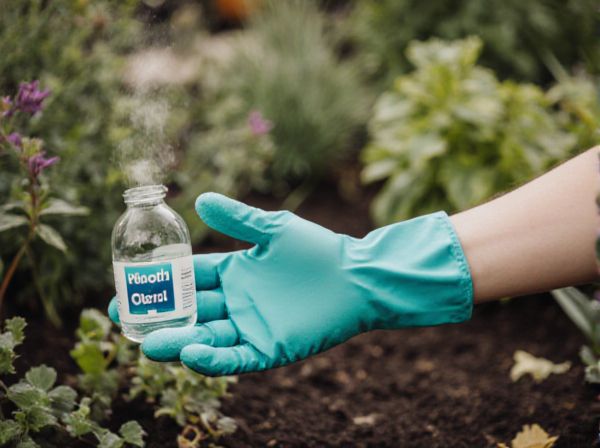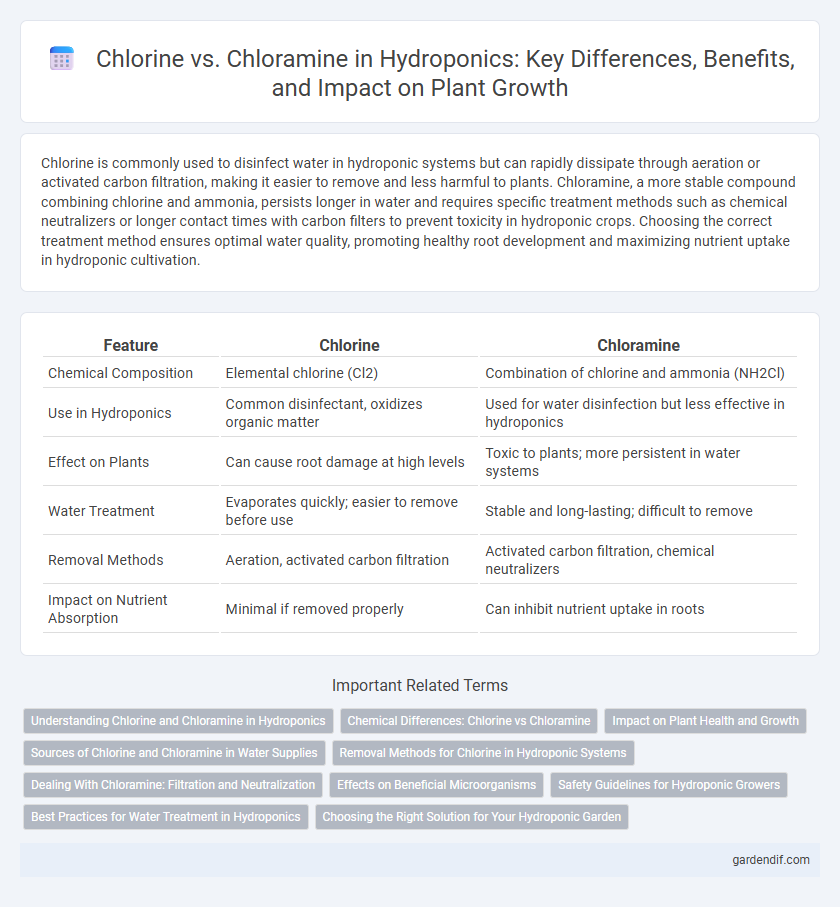
Chlorine vs Chloramine Illustration
Chlorine is commonly used to disinfect water in hydroponic systems but can rapidly dissipate through aeration or activated carbon filtration, making it easier to remove and less harmful to plants. Chloramine, a more stable compound combining chlorine and ammonia, persists longer in water and requires specific treatment methods such as chemical neutralizers or longer contact times with carbon filters to prevent toxicity in hydroponic crops. Choosing the correct treatment method ensures optimal water quality, promoting healthy root development and maximizing nutrient uptake in hydroponic cultivation.
Table of Comparison
| Feature | Chlorine | Chloramine |
|---|---|---|
| Chemical Composition | Elemental chlorine (Cl2) | Combination of chlorine and ammonia (NH2Cl) |
| Use in Hydroponics | Common disinfectant, oxidizes organic matter | Used for water disinfection but less effective in hydroponics |
| Effect on Plants | Can cause root damage at high levels | Toxic to plants; more persistent in water systems |
| Water Treatment | Evaporates quickly; easier to remove before use | Stable and long-lasting; difficult to remove |
| Removal Methods | Aeration, activated carbon filtration | Activated carbon filtration, chemical neutralizers |
| Impact on Nutrient Absorption | Minimal if removed properly | Can inhibit nutrient uptake in roots |
Understanding Chlorine and Chloramine in Hydroponics
Chlorine and chloramine are commonly used disinfectants in municipal water supplies, but their impact on hydroponic systems differs significantly due to their chemical properties. Chlorine readily evaporates from water, making it easier to remove before introducing water to hydroponic plants, while chloramine is more stable and requires specific treatment methods such as activated carbon filtration or chemical neutralizers to prevent toxicity. Understanding the differences between chlorine and chloramine is crucial for maintaining optimal nutrient uptake and preventing root damage in hydroponic agriculture.
Chemical Differences: Chlorine vs Chloramine
Chlorine is a highly reactive chemical commonly used as a disinfectant, existing primarily as Cl2 or hypochlorous acid (HOCl) in water, while chloramine is a more stable compound formed by combining chlorine with ammonia (NH2Cl). Chlorine rapidly dissipates from water due to its volatility, whereas chloramine persists longer, providing extended disinfection but less immediate oxidation. Hydroponic systems often require careful management of these chemicals because chlorine can damage plant roots and beneficial microbes, whereas chloramine's stability demands additional treatment to avoid phytotoxic effects.
Impact on Plant Health and Growth
Chlorine in hydroponic systems can cause nutrient imbalances and damage beneficial root microbes, leading to stunted growth and reduced plant health. Chloramine, a more stable disinfectant, tends to persist longer in water, posing a greater risk of toxicity and inhibiting nutrient uptake by plants. Proper water treatment to remove or neutralize chlorine and chloramine is essential to maintain optimal hydroponic plant growth and vitality.
Sources of Chlorine and Chloramine in Water Supplies
Chlorine is commonly introduced into municipal water supplies as a primary disinfectant to eliminate pathogens, typically sourced from chlorine gas or sodium hypochlorite. Chloramine, a compound formed by combining chlorine and ammonia, emerges from water treatment processes aiming to provide longer-lasting disinfection compared to free chlorine. Both chlorine and chloramine can originate from surface water or groundwater supplies, with their concentration levels varying based on regional water treatment practices and the type of water source.
Removal Methods for Chlorine in Hydroponic Systems
Effective removal of chlorine in hydroponic systems is commonly achieved through activated carbon filtration, which adsorbs chlorine molecules, preventing plant toxicity. Dechlorination tablets or drops containing sodium thiosulfate chemically neutralize chlorine rapidly, making water safe for nutrient uptake. Boiling or allowing water to sit for 24-48 hours also facilitates chlorine dissipation, ensuring optimal plant growth conditions.
Dealing With Chloramine: Filtration and Neutralization
Chloramine, a stable disinfectant used in municipal water supplies, requires specialized filtration methods such as activated carbon or catalytic carbon to effectively remove it from hydroponic systems. Neutralization techniques involving chemical agents like sodium thiosulfate or ascorbic acid help break down chloramine, preventing root damage and ensuring optimal nutrient uptake. Proper treatment of chloramine safeguards plant health by maintaining water quality, essential for high-yield hydroponic cultivation.
Effects on Beneficial Microorganisms
Chlorine in hydroponic systems can harm beneficial microorganisms by disrupting their cellular processes, thereby reducing their effectiveness in nutrient cycling and plant growth promotion. Chloramine, a more stable compound, tends to persist longer in water and can cause prolonged toxicity to microbial populations, leading to impaired biofilm development essential for root health. Maintaining balanced microbial communities requires careful water treatment to mitigate the negative impacts of chlorine and chloramine residues on these crucial organisms.
Safety Guidelines for Hydroponic Growers
Chlorine is commonly used to disinfect hydroponic water, but its strong oxidizing properties can damage plant roots and beneficial microbes if not properly managed. Chloramine, a combination of chlorine and ammonia, persists longer in water and is harder to remove, posing greater risks of toxicity and biofilm buildup in hydroponic systems. Hydroponic growers should regularly test water parameters, use activated carbon filters to remove chloramine, and adjust treatment protocols to maintain safe levels that protect plant health and system integrity.
Best Practices for Water Treatment in Hydroponics
Chlorine is widely used for disinfecting hydroponic water due to its strong oxidizing properties but can rapidly dissipate, requiring frequent monitoring. Chloramine, a more stable compound formed by combining chlorine and ammonia, persists longer in water but can be more challenging to neutralize, potentially affecting nutrient availability and plant health. Best practices for hydroponic water treatment involve dechlorinating with activated carbon filters or chemical agents like sodium thiosulfate, regularly testing for residual chlorine or chloramine levels, and ensuring balanced pH to optimize nutrient uptake and prevent root damage.
Choosing the Right Solution for Your Hydroponic Garden
Chlorine is widely used to disinfect hydroponic water due to its rapid effectiveness in killing pathogens, but it can dissipate quickly, requiring frequent monitoring and treatment. Chloramine, a more stable compound combining chlorine and ammonia, offers longer-lasting disinfection but may harm beneficial microbes essential for plant growth. Selecting between chlorine and chloramine depends on balancing effective pathogen control with maintaining a healthy root environment in your hydroponic garden.
Chlorine vs Chloramine Infographic

 gardendif.com
gardendif.com